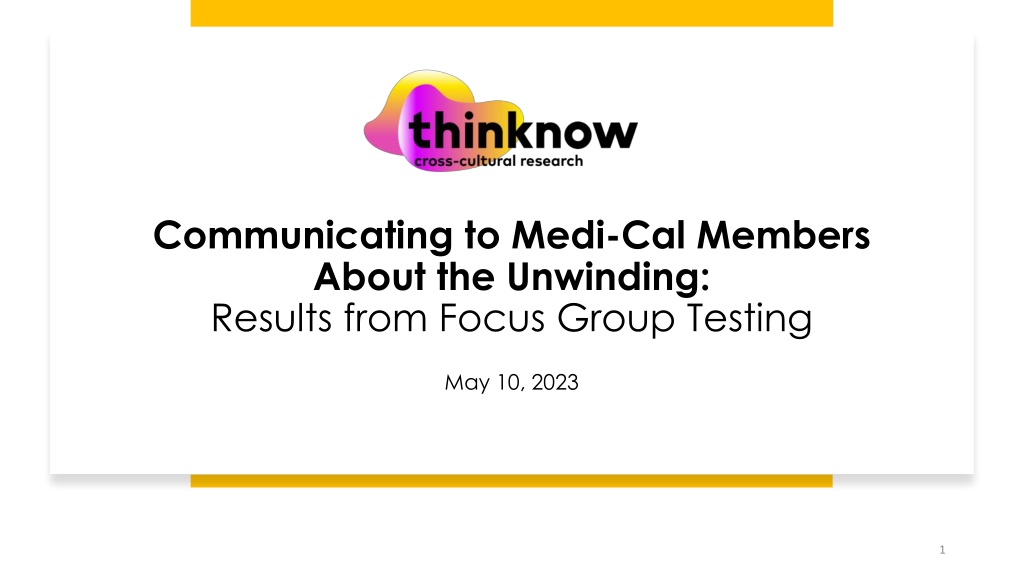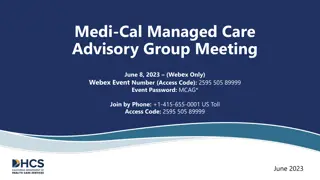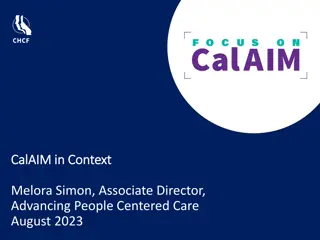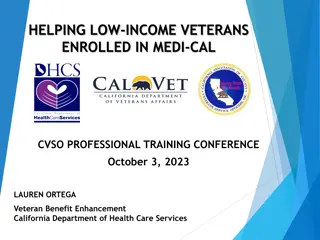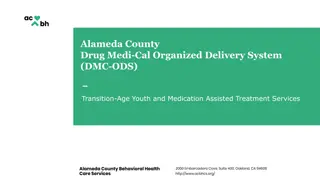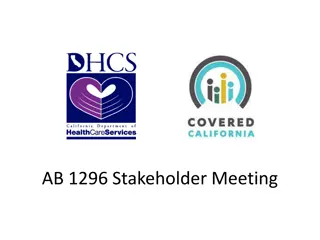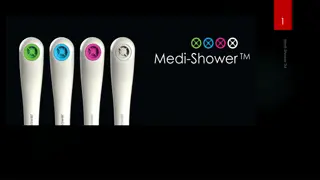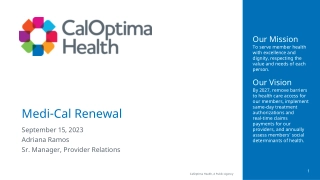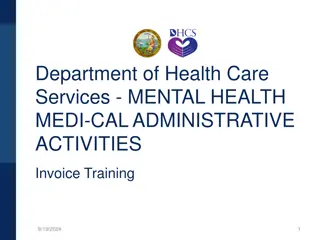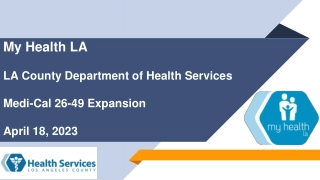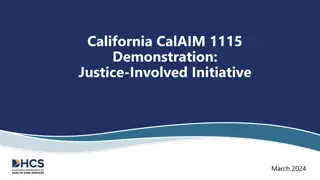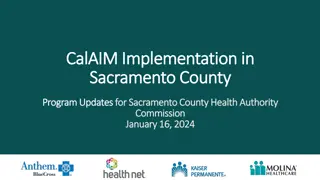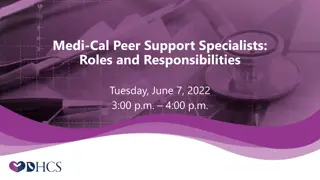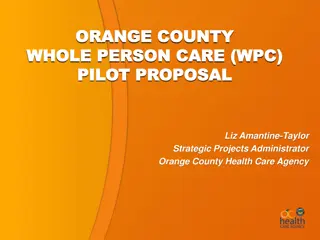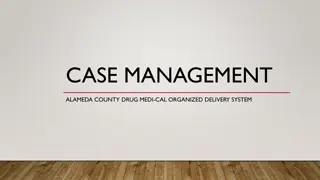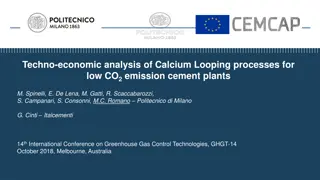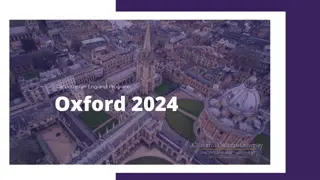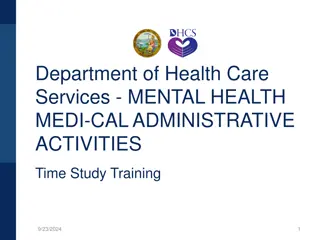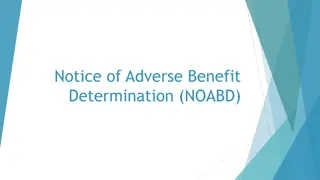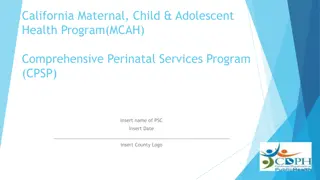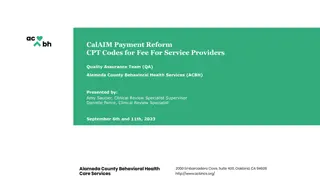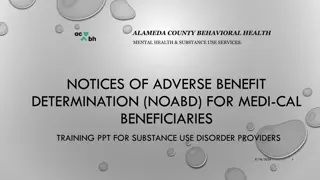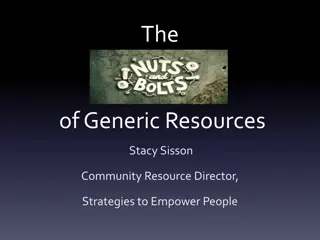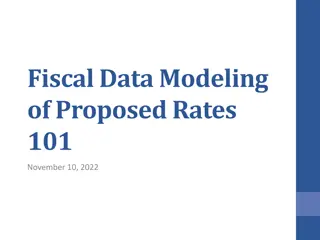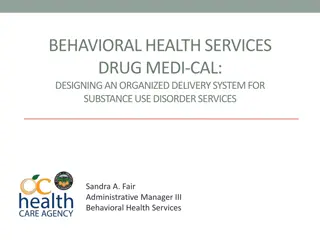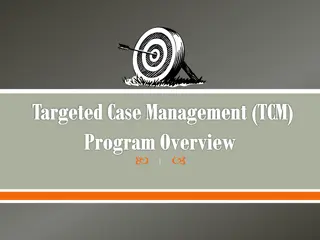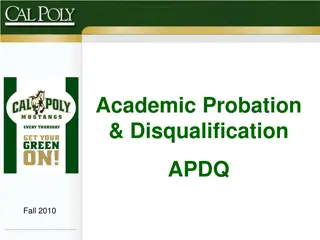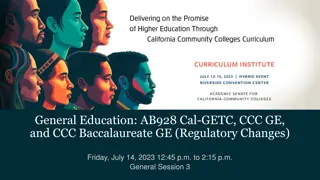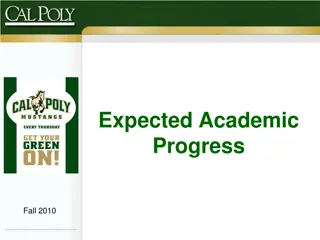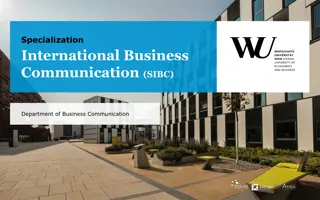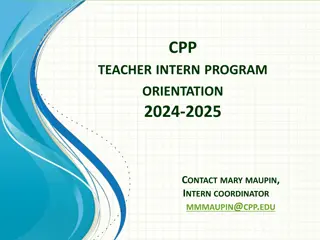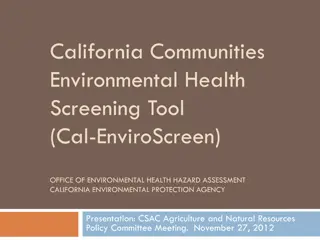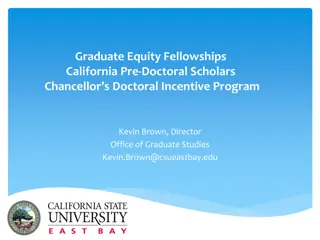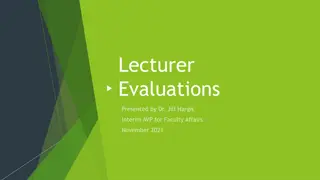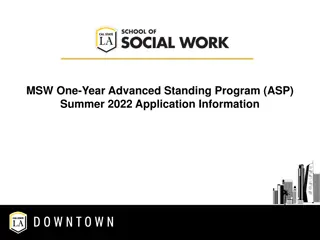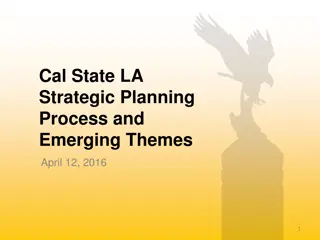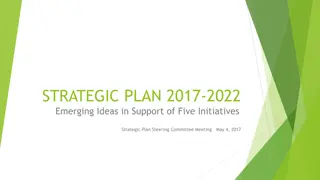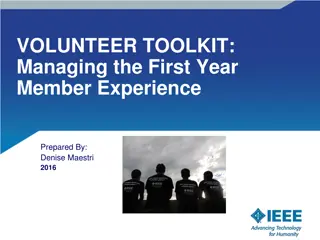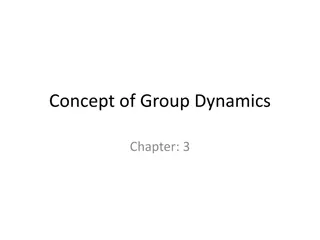Understanding Medi-Cal Member Communication: Focus Group Results
The research aimed to assess the effectiveness of communication materials by the DHCS to inform Medi-Cal members about necessary actions during the continuous coverage unwinding period. Through focus groups and interviews, insights were gathered on awareness levels, preferred communication channels, and trusted voices in Medi-Cal information dissemination. Participants were diverse in race/ethnicity, age, and Medi-Cal enrollment status, providing valuable feedback for future outreach efforts. The study ran from mid-December 2022 to February 15, 2023, and focused on Phase 1 materials primarily. The report presents observations from all sessions conducted online.
Download Presentation

Please find below an Image/Link to download the presentation.
The content on the website is provided AS IS for your information and personal use only. It may not be sold, licensed, or shared on other websites without obtaining consent from the author. Download presentation by click this link. If you encounter any issues during the download, it is possible that the publisher has removed the file from their server.
E N D
Presentation Transcript
Communicating to Medi-Cal Members About the Unwinding: Results from Focus Group Testing May 10, 2023 1
OBJECTIVES & METHODOLOGY 2
Methodology Objectives The research consisted of 15 focus groups and 19 in-depth interviews (IDIs) among 118 California residents. The research began in mid- December 2022 and concluded on February 15, 2023, before Congress passed legislation paving the way for ending the federal continuous coverage requirement effective March 31, 2023. Most of the research study focused on Phase 1 materials. Phase 2 materials became available toward the end of the study and were introduced in the last focus group and three IDIs. Focus groups lasted 90 minutes and IDIs 60 minutes; all were conducted via an online platform. Note that many changes have been made in communications materials since this testing. The California Department of Health Care Services (DHCS) has developed content aimed at informing Medi-Cal members about the actions they need to take to maintain uninterrupted health coverage during the continuous coverage unwinding period. The primary objectives of this study are to: 1. Test the effectiveness of the DHCS messages and materials. 2. Gather additional relevant insights that could be used to inform future outreach and education efforts about the unwinding. Some of these insights would center on gauging awareness of the upcoming unwinding period and Medi- Cal s redetermination process, assessing preferred communications channels, and identifying who the trusted voices are for Medi-Cal information. Study participants were recruited to meet these criteria: Mix of race/ethnicities (per research design) Men and women Age 18+ Medi-Cal enrollees or likely enrollees based on income and other factors, such as Medi-Cal card or Medi-Cal health plan card Decisionmakers regarding health care coverage for household Caregivers for a senior or person with a disability enrolled in Medi-Cal Fluent in the language of the session (English, Spanish, Cantonese, or Vietnamese) This report summarizes observations from all sessions. 3
Research Design The focus groups and IDIs as depicted in the table. Study participants were recruited via a combination of market research recruiter outreach and DHCS s outreach (multilingual email campaign to existing enrollees). General population sessions comprised a mix of races/ethnicities that included self-identified Caucasian/White, Black, Latino/x, and Asian. All sessions were conducted by professional market research moderators via an online platform (Discuss.io). All moderators were native speakers of the language in which the sessions were conducted. All sessions were audio and video recorded. Sessions were conducted between December 15, 2022, and February 15, 2023. Group (Group Language) General Population (English) Latino/x (Spanish) Chinese (Cantonese) Vietnamese TARGET 1: Broad Medi-Cal Population NorCal SoCal Valley/Rural Mix of Regions (Phase 2) Caregiver of Seniors/People with Disabilities TARGET 2: Higher Risk of Disenrollment a. People Experiencing Homelessness / Housing Insecure b. Undocumented Immigrants (Primarily Age 19 26) c. Households with Mixed Immigration Status d. Seniors, People with Disabilities 1 group 1 group 1 group 1 group 1 group 1 group 1 group 1 group 1 group 1 group 1 group 1 group 1 group 1 group 1 group 11 IDIs 8 IDIs N/A N/A (7 Phase 1 and 3 Phase 2) N/A N/A N/A N/A N/A N/A 4
Participant Profile A total of 118 California residents participated in the study. The participants were either Medi-Cal enrollees (or likely enrollees based on income) or caregivers for a senior or person with a disability enrolled in Medi-Cal. General Population Latino/x Chinese Vietnamese 40* 33 23 22 Total Participants Range: Avg. age: 20 72 42 21 61 45 18 74 45 21 63 44 Age Gender Male Female 19 21 13 20 10 13 8 14 NorCal SoCal Valley/Central 11 17 12 5 17 11 9 13 8 7 Region Avg. # of people Household Size 3 4 3 2 Avg. # of children Households with Children 3 2 2 1 Range: Monthly Household Income Less than $1,562 to $3,734 Less than $1,562 to $4,277 Less than $1,562 to $3,734 Less than $1,562 to $6,449 * Nine of the 40 general population participants (one focus group and three IDIs) were exposed to Phase 2 messages. All others evaluated Phase 1 messages. A nonbinary option was offered in the gender question. No participants selected this option. Participant-reported in ranges. Figures reflect full range. 5
Methodology: Participant Profile Latino/x (Spanish) General Population (English) Chinese (Cantonese) Vietnamese TARGET 1: Broad Medi-Cal Population NorCal Focus Groups 6 people 4 people 7 people 8 people SoCal Focus Groups 6 people 8 people 8 people 7 people Valley/Rural Focus Groups 6 people 6 people Mix of Regions Focus Group (Phase 2 Messages) 6 people Caregivers of Senior / Person with Disability 6 people 7 people 7 people 8 people Focus Groups TARGET 2: Higher Risk of Disenrollment a. People Experiencing Homelessness / Housing Insecure 2 people 3 people N/A N/A b. Undocumented Immigrants (primarily age 19 26) 2 people 2 people N/A N/A c. Households with Mixed Immigration Status 3 people 1 person N/A N/A d. Seniors, People with Disabilities 4 people 2 people N/A N/A
Monthly Household Income* Ethnicity 33Northern California 54 Southern California 23 Valley/Central 118 Total Participants 48 46 6 18 Asian / Pacific Islander Hispanic / Latino/x Black / African American White / Caucasian American 42 27 13 15 5 1 1 14 Less than $1,562 $1,563 $2,106 $2,107 $2,649 $2,650 $3,191 $3,192 $3,734 $3,735 $4,277 $6,449 or higher Did not specify Disabilities* 5 Back / knee problems 1 ADHD 1 Alzheimer s 1 COPD sEMA 1 Eyesight problems 1 Heart attack 1 Language barrier 1 Rheumatoid arthritis 3 Physical disability unspecified 2 Have one but did not specify 50 Men 68 Women Alameda County (4) Contra Costa (2) Fresno (9) Kern (4) Los Angeles (31) Monterrey (1) Orange (10) Placer (1) Riverside (2) Sacramento (3) San Bernardino (5) San Diego (6) San Francisco (11) 18 Age 20s 21 Age 30s 40 Age 40s 27 Age 50s 9 Age 60s 3 Age 70s San Luis Obispo (1) Santa Barbara (1) Santa Clara (15) Santa Cruz (1) Tulare (10) Ventura (1) * Monthly HH income and disabilities were self-reported. Note: Respondents were allowed to enter more than one disability. 7
Methodology: Screening Criteria Ethnicity:General Market (Asian, Black, Latino/x, non-Hispanic White, etc.), Asian, or Latino/x Age: 18+ (mix of ages) Mix of men and women, parents/nonparents Medi-Cal enrollee or likely Medi-Cal enrollee based on income, household size, enrollment card, and reported enrollment in SSI. Decisionmakers regarding health care coverage for household California residents: o Northern California (Alameda, Butte, Colusa, Contra Costa, Del Norte, El Dorado, Glenn, Humboldt, Lake, Lassen, Marin, Mendocino, Modoc, Monterey, Napa, Nevada, Placer, Plumas, Sacramento, San Benito, San Francisco, San Mateo, Santa Clara, Santa Cruz, Shasta, Sierra, Siskiyou, Solano, Sonoma, Sutter, Tehama, Trinity, Yolo, and Yuba County) o Southern California (Imperial, Los Angeles, Orange, Riverside, San Bernardino, San Diego, San Luis Obispo, Santa Barbara, and Ventura County) o Central Coast o Central Valley Higher risk of disenrollment segments: o People experiencing homelessness / housing insecure o Undocumented immigrants (primarily age 19 26) o Households with mixed immigration status o Seniors, people with disabilities (and caregivers of seniors/people with disabilities) 8
Qualitative Research Disclaimer The findings contained in this report are qualitative; therefore, they should be considered directional rather than conclusive. Qualitative research is a rich source of material and is valuable for clarifying existing theories and generating new information and ideas for further research. Although participants were drawn from the population from whom we seek answers and want to understand, they do not represent the population statistically. They are derived from a small sample of specially recruited residents. Furthermore, the manner in which questions are posed and answered during the group sessions may vary due to the flow of the discussion. As such, findings can not be projected to the larger population and should be considered directional. 9
EXECUTIVE SUMMARY 10
Communications with Medi-Cal, Awareness of PHE, and Upcoming Renewal Period In general, familiarity with the public health emergency and how it impacted Medi-Cal renewals was low; moreover, no one was aware of the unwinding period. Some participants were surprised to learn that their coverage could be negatively impacted if they do not update their information soon. With the exception of a few newer Medi-Cal enrollees, all are accustomed to receiving annual redetermination and/or renewal communications from Medi-Cal via regular mail. In general, study participants know they have to complete the renewal processes each year to keep coverage. Some, however, say they normally don't have to do anything, as it automatically renews for them. Medi-Cal enrollees in this study are concerned about doing their part to keep their Medi-Cal coverage and take this to heart. Therefore, they feel it is very important that they pay attention to upcoming written information about Medi-Cal that is mailed to them, as they do not want to risk losing coverage. Some also use phone, email, and official online accounts to communicate with Medi-Cal. Some use health plan apps. 11
Preferred Communications Channels and Trusted Voices Although study participants are social media users, they are not actively looking for information about Medi- Cal on social media. Mail is the preferred and de facto channel of communications with Medi-Cal. Although for many, perusing Medi-Cal documents can be tedious and confusing, it is generally considered the safest and most trustworthy informational channel. Mail also represents the usual form of official communication from Medi-Cal, the format these enrollees have come to expect from Medi-Cal. When it comes to receiving urgent messages, many prefer a combination of mail, email, and text. Mail, however, is considered too slow for receiving urgent information since recipients may put these documents aside and look through these documents at their convenience. Many stated that they do not get their mail reliably or at all, reinforcing the need to use multiple message channels to ensure prompt delivery of the information. A phone call is less preferred for receiving urgent messages from Medi-Cal, as they would likely not answer a call from an unknown number. The proliferation of scams via phone, in general, makes phone calls a less desirable option for study participants. However, several participants said they preferred to do business with Medi-Cal via a live conversation but complained about long wait times when they call Medi-Cal offices (either when speaking in English or when they need a translator), and that the verification of identity on the phone is difficult and laborious. 12
Preferred Communications Channels and Trusted Voices (contd.) Few are aware that online account access is an option. For some, the idea of checking eligibility without the usual long wait for telephone or in-person assistance is very appealing. Caregivers especially like this feature. There is low awareness of DHCS, and very few knew what the abbreviation stands for. However, some across all target segments do recognize the DHCS heart logo and associate it with Medi-Cal. County offices tend to represent the most credible (trusted) source for Medi-Cal information.WIC, the doctor s office, health clinics, community centers, and social workers are also perceived as trustworthy. For caregivers, Social Security is also a trusted source. In-language documents and messaging are appreciated by study participants who were interviewed in-language. While this is not surprising, given they were screened to be non-English preferred, some prefer their native tongue even if they know enough English to understand written information. Others like to receive both in-language and English, as they often find translations to be less than perfect for these types of documents. 13
Segment Differences Overall, study findings were consistent across the different race/ethnicity segments included in the research. The few differences observed tended to be anecdotal and not necessarily reflective of the majority in each segment. MEDI MEDI- -CAL RENEWALS CAL RENEWALS TRUSTED INFORMATION CHANNELS TRUSTED INFORMATION CHANNELS MEDI MEDI- -CAL COMMUNICATIONS CAL COMMUNICATIONS Chinese respondents seemed more informed about the upcoming renewals. Only a few in other segments voiced awareness, although many expected they would need to renew at some point. To some extent, more Chinese/Vietnamese respondents than those in other segments recognize the DHCS logo and thought the logo can appear on its own, without the name of the agency spelled out. This segment also thinks that partnerships with insurance companies, health clinics, hospitals, local nonprofits, and other government programs would help catch attention to the messages and generate trust. Some Spanish-dominant Latino/x and Chinese/Vietnamese enrollees prefer that communications from Medi-Cal come via regular mail; this format is perceived as safe. Some general market participants think text messages are convenient and a good alternative to printed materials, which is perceived as wasteful. In contrast, Latino/x participants think text messages lend themselves to being ignored, as they could be perceived as fraudulent. Some GM and Chinese/Vietnamese respondents had the impression that Medi-Cal renewals were automatic. Latino/x respondents were concerned that by renewing, they would be asked for new (or different) requirements. The local county is perceived as a trusted source of Medi-Cal information for GM and Latino/x, as it is related to government. Only Chinese/Vietnamese respondents voiced a desire for urgent information to come via email. However, this is not as a replacement for regular mail.
Phase 1 Messages Tested Study participants were exposed to one flyer and four social media ads from the Phase 1 campaign. The flyer was always shown first; social media ads followed, in a randomized order across the sessions. Reactions were gathered about message communication/clarity, call to action, and relevance. M K P R 15
Reactions to Phase 1 Messages Tested Overall, study participants appreciate the information and forthcoming efforts to inform the public about the upcoming renewals. Medi-Cal coverage is perceived as very important; therefore, communications related to keeping coverage are deemed relevant and important. In general, messages tested are not perceived to provide any new information. For the most part, these are deemed as good reminders to keep contact information current, but there is no strong sense of urgency or consequences for not acting upon it immediately. Many participants suggest the need for a deadline so they are more compelled to act promptly. Other than when noted below, there are no other major differences across racial/ethnic or language groups. Flyer Comprehensive in terms of the information provided and the number of options available to contact Medi-Cal offices Easy to follow, as the layout is perceived as clear Social Media Cards A good reminder to keep contact information current to mitigate risk of losing coverage Concept K (see previous slide) tends to be perceived as the most compelling because it was seen as the most generic (i.e., not specific to any situation) No urgent call to action Not clear who the message is from Not clear how to take action Relevant only if the person is in the situation depicted (e.g., Have you moved?) Not all understand what household changes refers to. Many hypothesized that it was related to the number of household members Some of the general population respondents perceive the visuals/colors as unappealing Strengths No new information for most enrollees; in some cases, perceived to be targeted to new members or those eligible but not yet enrolled Some of the general population participants feel it has too much information, or that the main message was not clear/direct enough In some cases, the graphics shown for the contact information needed is misunderstood as the different methods enrollees may use to contact Medi-Cal to update their contact information Weaknesses 16
Recommended Actions Based on the observations from the present study, the following recommendations are presented for consideration as DHCS works on the next round of communication associated with the upcoming renewal period and redeterminations. Clearly state the desired action and provide contact information where enrollees can reach out for questions and take action. For both the flyer and social media ads, consider eye-catching keywords that convey the need to act and the consequences of not acting. For example, consider keywords such as Urgent or Attention and consequences such as Keep your coverage or Don't lose your Medi-Cal. Include key dates and clearly explain that the renewals process starts in April. Let enrollees know that they will be notified (and state through which channel of communication) when it is their time to renew. Make it clear what the consequences are (e.g., losing coverage) for not taking action. Explain that for the past few years (during the COVID-19 public health emergency), the state placed a hold on redeterminations and disenrollments but that will be ending. Make it clear what members should expect when they go to the listed URLs (e.g., for informational purposes only, to create/update their online account). Also, clearly communicate that if they don t already have one, they would need to create an online account. Consider providing more than one form of outreach and response for example, a URL but also a phone number to accommodate a variety of preferred channels of communication. Ideally, since these are social media ads, Medi-Cal enrollees would be able to click on the ad or scan a QR code and be directed to a website to update their information. Spell out the name of DHCS. Many recognize the logo but don t know who it is for. Consider changing beneficiaries to members or other simpler terminology. Not all understand the word beneficiaries, and some mistake the term for benefits. Others find beneficiaries off-putting. 17
Recommended Translation Revisions: Chinese Recommended Revision [Change to Pay Attention ] Rationale Place on top. Recommended to appear more urgent. Change in household member may be more specific. Flyer and All Ads [ Household change here is unclear. Consider changing to or change in household member ] ? [Have you moved or are you moving?] Medi-Cal [Unclear who qualified Medi-Cal county eligibility worker is. Change to Medi-Cal Please contact your local Medi-Cal office would be better.] Social Media Ad: R Social Media Ad: M Consider this change, as the terminology would be more appropriate. Social Media Ad: K 18
Recommended Translation Revisions: Vietnamese Recommended Revision s c kh e [health] m b o should be b o m Rationale These two words should go together in the same line. The original translation is communism terminology; the proposed term will make it flow better and will be more understandable to Vietnamese people in the US. Missing a word to complete the translation for county. The original translation for contact means physical contact; it should be changed to li n l c. The original means the side that receives Medi-Cal benefits, not a person. It should be changed to Ng i Th H ng. These two words should go together in the same line. These two words should go together in the same line. The original translation for contact relates to physical contact. Flyer qu n should be qu n h t li n h should be li n l c Social Media Ads B n should be Ng i Qu v [ you formal address] b o hi m [insurance] li n h should be li n l c There are no recommended translations for Spanish. 19
Objected or Misunderstood Terms Regardless of participants reactions to the messages tested during this study, there were some terms that were not clearly understood by all. Eligibility workermakes some people think it is pertaining only to enrolling. Participants reported the term case worker is what they would use, particularly when it comes to renewing their Medi-Cal or reporting changes. Beneficiary is misunderstood by some as someone who is due something upon death (e.g., a heir). Household changes is clear to some, but it was not clear to many. The term is open to interpretation, which is not ideal in the context of the messages. 20
Phase 2: Messages Tested T S Nine participants were exposed to the Phase 2 media ads (most of the focus groups and IDIs had already been conducted when the Phase 2 ads were ready for testing). Phase 2 messages tested were in English and included one card, two flyers, two social media ads, and five text messages. Reactions were gathered about message communication/clarity, call to action, and relevance. Text messages will be customized with links (for a county Medi-Cal office, for example). Since participants were from different counties, the link to the DHCS home page was substituted. This let us probe on how participants reacted to .gov (versus .org) links. Flyers V H Social Media Ads Card 21
Phase 2: Text Messages Tested To get your Medi-Cal renewal letter, make sure you ve updated your contact information if it changed recently. You can report information in person, phone, mail, or online: www.dhcs.ca.gov Don t miss your Medi-Cal renewal letter. Update your contact information in person, phone, mail, or online, if it changed: www.dhcs.ca.gov Take action to keep your Medi-Cal. Make sure your address is up to date, so you get your renewal letter. You can report information in person, phone, mail, or online: www.dhcs.ca.gov Medi-Cal renewals are coming soon. Make sure your address is up to date. You can report information in person, phone, mail, or online: www.dhcs.ca.gov Did you get a Medi-Cal renewal packet? Fill it out and return it to your county in person, phone, mail, or online, as soon as possible. www.dhcs.ca.gov 22
Key Findings from Phase 2 Campaign Many of the key themes that emerged from the Phase 1 campaign were also observed for the Phase 2 messages. In general, and based on a sample of nine people: The card does not provide any new information for current Medi-Cal enrollees. The flyers are perceived as more informative than the card, and each has elements that appeal to different people. Flyer T provides information on Medi-Cal coverage, and that catches enrollees attention. Flyer S provides a catchy headline that directly invites readers to take action; the diagram provides a clear depiction of what action enrollees need to take based on their particular situation. It leaves readers with clear direction on what to expect and what they d need to do. The social media ads generated lukewarm reactions, as they did not provide contact information or any specific call to action. Concept V, however, seemed to generate more interest, as it is explicit about informing readers to expect a letter. Of the text messages, these two were preferred, as they were more specific about what action was needed. Take action to keep your Medi-Cal. Make sure your address is up to date, so you get your renewal letter. You can report information in person, phone, mail, or online: www.dhcs.ca.gov Did you get a Medi-Cal renewal packet? Fill it out and return it to your county in person, phone, mail, or online, as soon as possible. www.dhcs.ca.gov Most, however, admitted that they would not click on the provided URL, particularly if these text messages are not personalized; they fear fraudulent messages and try to be cautious. The .gov links, however, tend to be more trustworthy than .org links. The flower (California poppy) was not associated with Medi-Cal, and only one participant associated it with California. 23
